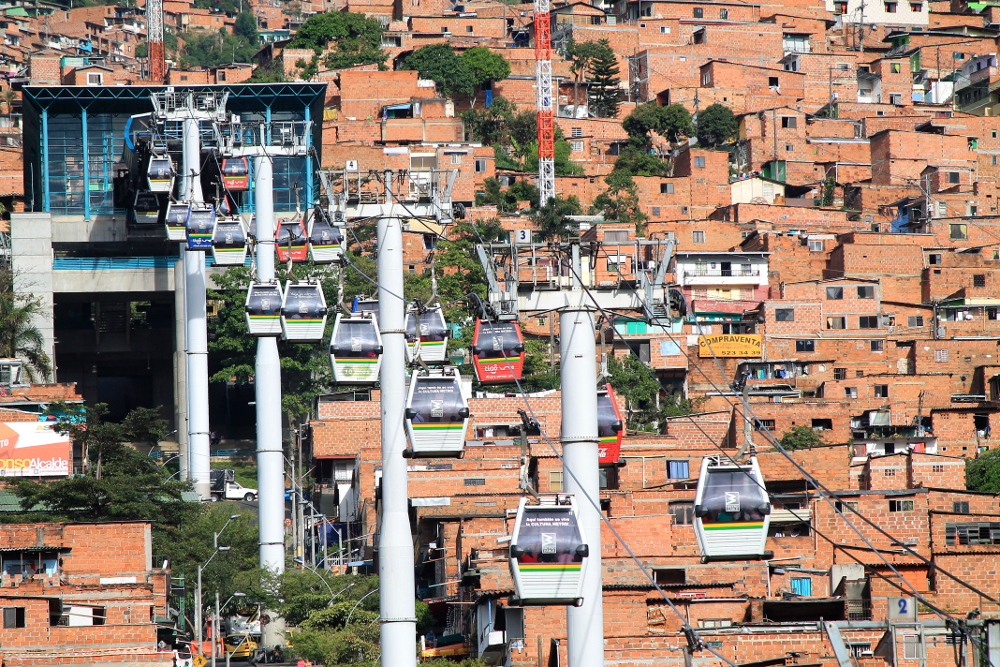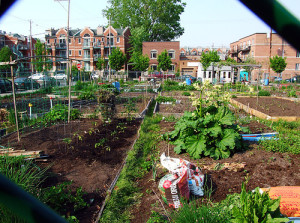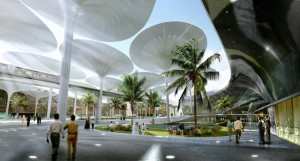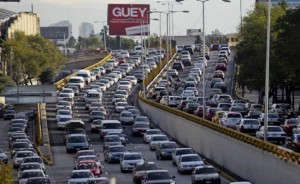Medellín – The Future of Latin American Cities
Latin America is one of the most urbanised regions on the planet, but it also has one of the world’s highest level of inequality, which means a huge gap between wealth and huge poverty. Adaptation to current circumstances, such as climate change offers a big opportunity for urban areas and cities to use this issue as an opportunity to make themselves more efficient, more sustainable, and smarter and thus close the gap of inequality. A better infrastructure, a better public transport system, a more efficient energy, waste and water management with the focus drawn to a strong social component can improve quality of life and create financial benefits for all citizens. One of Latin American’s ideal examples of a sustainable and smart city is Medellín in Colombia. A city which for a long time was known for drugs, Escobar, corruption and a high crime rate, but times have changed and today the city in the north of Colombia represents the future of how Latin Americas cities can be one day. Medellín is definitely on track, it used the power of rapid growth, converted it in a dynamic energy source and got prepared for future challenges, such as the satisfaction of the needs of its almost 3.8 million inhabitants. It was in the late 90’s when Medellín has recognized the signs of the time and started to lead a change towards social inclusion by focusing on innovation, technology and infrastructure. It was a time when the city was still healing the scars of a violent history, but public leadership and dialogue with its citizens changed the attitude of the city, increased efficiency in public services and made Medellín to a hub for innovation, investment and entrepreneurism.
A milestone in terms of public services was definitely the massive improvement of its public transport system. Foremost the cable-car system, or so-called MetroCable, got first planned and designed and then succesfully reformed and adapted. Today it connects various spots of the city in an efficient and intelligent way and thus day by day helps hundreds of thousands of people to avoid lengthy and dangerous commute. A two and a half hour commute was reduced to less than half an hour when the first new MetroCable line of this revolutionary transit system was inaugurated in August 2004. Also the impact on the environment is remarkable, through the high use of public transport systems Medellín saves more than 20.000 t CO2 every year.
Besides the improvement of the public transport system, the focus on a “social urbanism” philosophy was one of the main drivers of the change in the city. As a result today Medellín has one of the lowest amounts of waste production per capita of Latin American big cities. Furthermore it has one of the best wastewater treatment management systems and the highest percentage of people with access to sanitation compared to other cities in its income bracket. This continuous improvements are supported and regularly get reinforced by various “green initiatives” for further improvements in water infrastructure, congestion reduction and a strong focus on the development in low-income areas. All these urban management actions have redesigned the city and reopened the space for dialogue and thus strengthened the successful process of social inclusion. Another tool for it is the city’s strategy on connection and communication within the city. Around the city there are more than 60 free Wi-Fi hot spots what gives all citizens the permanent opportunity to be online and thus it facilitates their daily life. In terms of entrepreneurism free open spaces and offices are offered by the public and so offers a platform for entrepreneurs, students, teacher and any kind of creative individuals to come together. This increases continuously the potential of innovation and entrepreneurship in the city and thus attracts investment and talent.
In conclusion, Medellín is the perfect example which path Latin America’s big cities have to choose in the future. The focus on innovation and infrastructure with the superordinate goal of social inclusion must be the key of any urban strategy. As mentioned at the beginning the gap between poor and rich is tremendously huge in Latin American. However, the success story of Medellín can be an incentive for other urban governments around the continent in order to take the right decisions and thus create prosperity and wealth for all citizens. No doubt that the challenges of urban planning will be one of the most crucial ones in Latin America for the next decades. The migration towards cities is unstoppable and the speed of this migration is critical. The signs of the time have to be recognized and the change must be initiated and leaded soon. Only then the future for Latin American cities will be a bright one, one where the gap between the poor and the rich will incrementally fade. Like in Medellín since the late 90’s!
Urban Farming: The case of Rotterdam
The concept of urban farming or urban agriculture is surely not a new kind of practice, it has however gained a lot of traction in the recent years. It is defined by the practice of cultivating, processing and distributing food within a town or city. The activity of urban farming, like the name states is undertaken within an urban space. In order to fully understand this practice it is essential to provide a certain amount of context to the term.
There is no doubt in saying that today we live in an interconnected world, where more people live within urban areas than in rural ones, with an amazing 54% of the world’s population residing in cities as of 2014. Urban living is on the rise whereas rural living is becoming an exception. This trend is happening in all parts of the world and at an expanding rate. We cannot deny the facts, our world is shifting towards an urban, small – family household. Many individuals may see this as a danger, as living in urban settings can be threatening in so many ways. For instance, if an individual doesn’t have enough personal space, together with insufficient security or unstable economic conditions this may result in stress related health consequences.
On the other hand, I tend to believe that the increasing urban living phenomenon represents a great potential in terms of finding adequate opportunites for society. In point of fact, I acutally see urban farming as a perfect example of urban living opportunities. Urban agriculture can be considered as a result of the migration of individuals from rural to urban areas. Through reflection, people residing within cities are naturally more exposed to food insecurity, due to the greater supply risks involved in bringing food to them. Therefore I believe people become innovative in order to find adequate and sustainable measures to their potential issues. I really think cities can provide people with an environment that tends to foster greater creativity and productivity.
Interestingly enough urban farming can reflect a certain amount of economic and social development. In more developped countries, urban farming is currently considered as a social movement that searches for sustainable solutions for the well-being of their communities.
On the other hand, in southern countries that are still in the phase of development it has a whole different aspect. Their motivation to undertake urban farming activities is completely different. Understandably, in less developed nations, income generating, food security and nutrition are their main incentives for engaging in such activities ! (The world has definitely seen a certain amount of progress with regards to the fight against hunger. However, this being said it is still inadmissible that there is a considerable amount of people worldwide that continues to struggle and lack of food for ongoing a healthy life. According to the Food and Agriculture Organization (FAO) « About 795 million people in the world – just over one in nine – were undernourished in 2014 » (FAO , 2015) It is essential to point out that the majority of hungry people live in developing countries, where hunger persists in rural areas. These vulnerable communities are strongly depend on agriculture activities as a vital source of income and livelihood. Indeed in a developing country context, the motivation of communities, families, or simply individuals to get involved in such urban farming activities. This really underlines the real value of urban farming for poorer and vulnerable communities, where such activities will provide them with some sort of income or even just food for their families.
In the next section, we will explore the practice of urban agriculture in a specific city – Rotterdam. With this in mind we will try and understand Rotterdam’s aim with urban agriculture and the reason why they want to stimulate such practice.
The case of Rotterdam
There is no question in the ambition of Rotterdam’s municipality. They have high objectives and want to become a pioneer in the field of sustainability, with a city much cleaner and greener in order to enhance the health of citizens. An effort to create an eco-friendly environment, where people can enjoy outdoor spaces with various facilities. I believe the direct return of investment here is to see the city becoming a more attractive place to live and work in, which of course in the long – run will enhance the economic development of Rotterdam.
In recent years, we have noticed a global trend towards a more sustainable kind of food. Indeed society have a desire to change the way they eat, a desire for authentic and better quality products. The rise of movements such as slow food which « supports countries around the world who link the pleasure of good food with a commitment to their community and the environment » have gained in momentum and could potentially influence the municipality of Rotterdam as they have opened a branch within the city. The goal for the municipality would be to set up an enthusiastic food strategy in the coming years, however this is not in their current agenda. The municipality of Rotterdam have an objectif to maintain the spontaneous character of urban farming. This mainly involves grass-roots initiatives, from citizens and professionals who are already involved within this field. Organizations such as Buurtlab and Creatief Beheer are progressively combining social activation and gardening, with the purpose to contribute positively to the greening of districts which lack of green areas.
The municipality is ready to help and get things going. They have a desire for urban farming to be a combination of citizens initiative and entrepreneurship.
The relation between urban farming and happiness
One may think that the only outcome of urban farming lies within the end product, for instance the healthy natural vegetables that are of course GMO free ( Genetically Modified Organisms). This in a way is correct, however for the next part of this blog post, we are going to focus on the bigger picture – the real value of urban farming and what it creates. I strongly believe that urban farming agriculture is about much more than just growing food, it is an activity directed towards community development goals. Of course, it is essential to highlight the fact that urban farms differ drastically from one another with regards to their objectives, structures and locations. Some may focus on production in order to obtain some sort of profits (depending on their context), or they may make social and educational goals their priority. It may also provide hefty health, ecological and economic advantages to communities, which in the case of vulnerable communities may have a spill over effect as it would address certain social and economic issues within the community but most importantly it would help restore community pride and dignity !
Edouard Leonet
MASDAR CITY: A SUSTAINABLE MYTH?
We are currently facing the effects of climate change and there is no doubt that we need to initiate a change and act now in order to avoid catastrophic consequences in the future. Therefore various new ideas, concerning this issue, have been evolved. Ultimately, a lot of proposals regarding the construction of “eco-cities” have been considered. But, what does this concept mean?. Cities with a specific environmental focus that incorporate efficient buildings, comprehensive master planning, renewable energy sources and efforts to achieve resource self-sufficiency. Something that will result in smarter cities and in a reduction of the GHG.
The Masdar City Project is one of these proposals. A model of a carbon neutral and zero waste city designed by the famous British international architecture studio “Norman + Partners”. The project is in a city located 11 miles southeast of Abu Dhabi City, with an area of 2.3 square miles. The city, that is going to host 50.000 permanent residents and 40.000 daily commuters, will rely on solar energy and other renewable energy sources.
Although all this sounds like the ideal scenario for the future, the project has been hardly criticised. One criticism of the Masdar City project is the construction of a brand new city in a desert (an unquestionably resource intensive place) is completely unsustainable. Even though it will be carbon neutral, it also will require massive amounts of energy, land and water to construct and sustain. The surrounded area is a huge limited freshwater area, something that will cause massive shortages of water supply and thus is unsustainable at all. Another criticism is that the $22 billion cost of building Masdar City is funded almost entirely through revenues from oil and gas. In other words, funded by non-renewable and intensive polluting sources. In addition, The UAE (United Arab Emirates) is one of the worst countries in the world in terms of greenhouse gas emissions because of the country’s intensive activities related to oil and gas reserves. Hence, the concern of how effective this project will contribute to a successful reduction of the UAE’s greenhouse gas emissions as a whole is more than justified. Masdar city is supposed to be an example for other cities worldwide, but there is still a lot of doubts related to the significance of the impact this project can have in other cities. Model cities do not have a good track record of affecting large-scale changes in terms of urban planning practices.
By analysing all the critics that have arisen since the project was designed, from my personal point of view Masdar City it is still a step in the right direction. No project is perfect and no one can deny that Masdar is an interesting project that will help to develop green technologies. It’s true that the UAE economy relies on their vast reserves of oil and gas, but they have realized that economic growth based on fossil fuel production is unsustainable in the long term due to limited fossil fuel reserves. So, investing in this kind of projects is a great opportunity to diversify their economy while reducing the GHG emissions. Finally, since Masdar is a city made of innovation and new technologies it definitely will have positive impacts on smart city projects around the world, will deliver crucial learnings for the future and thus make cities smarter and the world more sustainable. However, since it is also an artificial city, Masdar does not have to face the huge challenges normal cities are facing ever since. Therefore the implementation of various elements of the Masdar model in other cities will be a difficult task which we should not underrate.
Urbanization and Climate Change: The Front-Line of Sustainability
Urbanization and climate change are transformative and defining issues of the 21st century. The ever increasing numbers of people concentrating in urban areas reflects the unprecedented growth of cities in the past half century.
To this point, between 1950 and 2014 the world’s urban population grew by 422 percent. Current projections estimate that by 2050 70 percent of the world’s population will reside in cities. The surge in urban populations is expanding the footprint of cities, making them the major sites for production, consumption and waste. Consider the following:
- Cities account for approximately 70 percent of global GDP
- Approximately 70 to 75 percent of all natural resources are consumed by cities
- Cities consume about 75 percent of global primary energy
- Cities emit more than 70 percent of global green house gas emissions
- Cities account for 50 percent of global waste
In many cases the rapid growth of cities are challenging established approaches and notions within urban planning (e.g., car centric vs. people planning) as well as presenting more systemic concerns regarding sustainability (e.g., pollution and waste, increasing development in hazard prone areas). Perhaps the biggest sustainability issue is climate change.
Available scientific evidence indicates that climate change that will continue to increase the frequency of extreme weather events (e.g., hurricanes/typhoons, tornados, winter storms, heat waves) and contribute to sea level rise (recent studies suggest that mean sea level rise could exceed 1 m by 2100). Moreover, new projections that estimate that disasters losses could top $300 billion per year in the coming decades.
Climate change is a risk multiplier. It is a game changer. As ground zero for mitigating and adapting to climate change, cities are well positioned to take action because of their unique mixture of political and financial clout, and disproportionate risk exposure.
While the imminent and growing risks of climate change may provide the impetus for ingenuity and innovation, urban sustainability cannot be achieved if we continue to conceive of, plan and build cities as we have.
In many respects, identifying and realizing the co-benefits of adaptation and mitigation must lead to the transformation of urban landscapes. Environmental destruction can be replaced with restoration. Cities do not have to be a burden on ecological systems. To this end, there are numerous opportunities to modernize food production, energy generation, waste management and transportation systems. For instance, decentralized energy generation by integrating solar and wind technologies into existing infrastructure (i.e. roads and buildings). Another example is the promotion of green spaces (e.g., expand and reclaiming park areas, green roofs, urban farms) to reduce heat island effects, increase porous surfaces for rainfall run-off and minimize flash flooding.
While the role of technology is unequivocal in the drive toward greater urban sustainability, it is important for city leaders and citizens alike to not be seduced by design. In other words, managing climate change and its related issues will require cities to be smarter. But smart cities cannot be limited to the incorporation of digital technologies, software and equipment into infrastructure. Cities must pursue a broad mix of structural and non-structural measures insofar as the policy choices effecting density, land use planning, building codes, mobility, poverty and social inclusion are equally important as the waste-to-energy plant or floating buildings.
The built form is not the end per se but a means to complement non-structural policies in achieving environmental, social and economic objectives related to climate change mitigation and adaptation. In turn both structural and non-structural measures must ultimately address the underlying dimensions (i.e. social, economic, environmental) of vulnerability and risk to climate change related impacts.
Cites are at the front-line of climate change and sustainable development. A pivotal opportunity for change and future prosperity. Such an opportunity, however is also accompanied by great expectation and responsibility because if cities do not sufficiently mitigate and adapt to climate change, the consequences are perilous.
Is banning the use of private cars the right answer?
Mexico City is one of the largest cities in the world with approximately 21 million inhabitants. But this city endures some of the worst smog levels worldwide, making the air pollution one of the most pressing issues for the government.
According to estimates of the Mexican Institute for Competitiveness A.C. (IMCO), in 2015 only in the Valley of Mexico 1,823 people died, 4,494 required hospitalization for respiratory diseases and cardiovascular diseases, in addition, 247,729 attended medical visits for respiratory infections, asthma and ischemic heart conditions.
In March 2016 Mexico City faced a huge environmental crisis, an environmental contingency caused by the poor quality of the air due to car pollution, this crisis led to the application of different anti-pollution measures to improve the index of air quality.
One of these measures is called “Hoy No Circula” (No drive day), a program in which each of the vehicles are categorized by two main factors: their level of emissions, that gives them a hologram after making a test, and also the digit termination of the plate, which defines the color of the sticker for the vehicle. With these two factors, the program defines who may or may not move around the city every day.
In my opinion this measure is very functional for the short term reaction needed due to the crisis of environmental contingency that the city is facing, but I believe that it is not the right answer for the long term, there are other options that need to be taken into account to tackle the problem in a sustainable manner.
Since its beginning 27 years ago (1989) “Hoy No Circula” has proven to not being sufficiently efficient in terms of discouragement of use of private cars in the long term. It works when the problem faced needs a quick response but it does not provide a solution to the number of private cars used in the city and the bad conditions of the public transport and other vehicles that are being used.
Also, preventing or banning the use of the cars in the long term could be counterproductive, as it would result in a blunting congestion with the increase in the vehicle fleet (cars parked without use).
The money obtained by the verification or the test of level of emissions of the vehicle, that gives them a hologram to circulate the city is supposed to be mainly used for the reform and reconstruction of roads and for the improvement of infrastructures in order to reduce traffic jams which is another big issue of the city.
With this, the solutions created or proposed only tackle the issue of use of old cars (more pollutant) and the reduction of traffic jams in peak hours. But it does not tackle the issue of pollution in the long term; it does not encourage the use of other alternative options of transportation.
This is why I think that the answer is not in banning the use of private cars but in the improvement of the quality of public transport and the creation of new alternatives to the usual way of mobility of the citizens. So in my opinion we should be focusing in measures that make more attractive to use public transport and less attractive the private one.
What kind of measures could help?
- Create affordable parking lots near the zones where the public transport starts its journeys so that citizens can leave their cars there and circulate in public transport.
- Create more car-free urban zones.
- Improve the quality of public transport such as Metrobus and the Metro, and increase their reach and improve the strategy, planning and control. For example nowadays most metro users have to wait at least 3 trains to be able get on the subway because of the exceeded capacity.
- Replace the existing “Microbuses” (most of them older than 20 years) and appoint determined stops for them.
- Improve roads for bicycles and pedestrians and increase their reach.
- Increase taxes for parking lots (where routes of public transport already exist) used by private vehicles to create a partial subsidy fund quality public transport.
I know that this sounds as an Utopia but we have to start doing something now in order to prevent bigger costs in the future, and most of these measures are already on track or in the plans for the city so we need to cooperate and make them a priority, action is needed in order for change to occur.
So, is banning the use of private cars the right answer? My answer is no. Don’t prohibit the use of private cars… Discourage it!
“A developed country is not a place where the poor have cars. It’s where the rich use public transportation.” Gustavo Petro.
What if a well-implemented CSR is the perfect strategy for your company?
I was talking about CSR and its importance in the actual businesses with a friend in the train on my way to Cádiz when a man interrupted me saying that what I was talking about it was not completely correct. He was a telecommunication’s engineer that had been in charge of a company for 15 years, until his retire. The perfect businessman.
His main argument was that generally, people need such a long time to be able to start a new business and their main objective is to be profitable as soon as possible. Invest in being eco-friendly or in being empathic with the community beside your company is something that comes (if comes) with the maturity of the enterprise. Invest in CSR is something that you will be able to do when you will be earning enough money.
The paragraph above relates what most of the people think in our days. And it is a fact that when you decide to invest in a new business you will want your money back soon. But, is not enough for a company to be efficient in the relations between suppliers and clients in order to maximize the profit. So, what if a well-implemented CSR is more than related with being successful within your company?
A lot of companies look to the CSR as a way of have a good reputation and as philanthropy, but CSR its more than that. As Jamsetji Tata said “ In a free enterprise the community is not just another stakeholder to business, but is in fact the very purpose of its existence”. It is about earning money while serving the wider interest. A company depends on the environment where it is performing. So, it is necessary to take it into account in order to ensure the future of the company. But is not all about the actions that a company is doing in order to serve a wider interest. When companies implement strategic CSR they can find there are many benefits, including strengthened corporate and brand reputations and enhanced trust with key stakeholders (customers, employees, suppliers or investors), improved risk management, increased revenues from innovation to identify new business opportunities, and reduced costs.
Marta Barahona
When the fact of being small does not mean small impact
Back in High School and during my degree, I have been taught that the main aim of every business is to make profit. Of course, there is no doubt that making money is necessary to sustain businesses in the short and in the long term. However, I consider this premise a very basic one, one with lack of ambition and aspirations. Maybe it seems contradictory having in the same phrase profit and lack of ambition, but bearing in mind a phrase of Peter Drucker, life is more than breathing, and doing business must go beyond making profit.
Nowadays, humans are creating and living a new global environment characterized by rapid change. Flexibility and adaptability into this changing world are the key challenges but also the solutions for companies to “manage” their stakeholders: attract talented people, satisfy customers and shareholders, and choose the most suitable suppliers according to the business preferences.
Big companies have a big impact on employment, wealth and investment, but also pollution for a country. Though, small and medium enterprises (SMEs) are as well, impact generators. In a worldwide basis, these small pieces of the big economic puzzle, the SMEs, account for around the 90% of the total firms. So, they cannot be avoided when talking about both positive and negative impacts locally, nationally and globally.
SMEs have become “micro-multinationals”, driven by the need for speed and flexibility in a worldwide job and consumer markets. This international atmosphere together with the Internet, make companies more vulnerable in terms of public information availability, but this fact opens a window for opportunities in order to build and spread trust among their stakeholders. Already created SMEs and also new ones, must take an advantage of this new reality.
Having in mind the word “manage” that I used at the beginning and looking at its definition “to be responsible for controlling or organizing someone or something, especially a business or employees”, is fair to reconsider the connotation it has as an unilateral approach. When it comes to taking into account your employees, the monologue must change into a conversation. Something that grows thank to both parts and helps companies’ culture to be more consistent and trustful.
Despite the fact that being responsible and taking care of employees or local communities is not something new, the increasing level of expectations from stakeholders in relation with companies’ behaviour, is the key factor that oblige firms to accomplish the promises they make. Nevertheless, if you want to build trust, be coherent and walk the talk, the first thing you have to do is to focus inside your company. In every company, employees are the pillars but also the façade of the firm, but in SMEs few people become the key players for the sustainability of the business. Having worked in an SME I have understood that if you want to succeed, there is no space for a clash of driving values between employees and the company. This example of coherency makes easy for the business to grow aligned in one unique direction. Moreover, in many cases, SMEs born to solve a problem or a need located in an specific area or that occur to the founders. Is because of this that, in many cases, mission, vision and values came before the birth of the firm itself, and they are the main drivers from the beginning of the SME.
Employees lives go beyond the need of oxygen to survive, so in terms of their career their expectations and needs go further profit generation. So, what they want from their job? They want to create an impact by doing good. And it is exactly the path that SMEs must want to follow.
Fátima Enríquez Lago, student of the International Master in Sustainable Development and Corporate Responsibility.
The dynamic world we live in
The world has become a dynamic process of integration and interaction among people, businesses, and nations; in other terms a world of globalization. Being in Namibia, Costa Rica or China, you are always connected and surrounded by people texting, talking or surfing the Internet on their phones. This current situation makes the information technology one of the most important assets of globalization, and has also changed the way people live and the way people do business.
Nowadays, all kind of work are based on the use of Internet. Corporations have been shifting from production and manufacturing businesses to more service-oriented businesses, where sharing and connecting people around the world became the main focus. Shaping the online environment has led to important creations of platforms such as Airbnb, Facebook, Booking.com and TripAdvisor among others, are tremendously increasing, letting people constantly communicate about their experiences, their journeys and their feelings about the service or product.
With the fast and dynamic world we live in, startup companies and Small and Medium Enterprises (SMEs) can be very easily developed, since they don’t require any kind of physical in kinds. More than 300 million of people are trying to create new startups and 50 million of them are launched yearly. The easiness you have to create your own SME is fascinating. Therefore, I personally think that following the trend of providing online-based services is very important and interesting for your business.
However in my opinion to keep up with this competitive world it is important to be different and to provide global services that add up values to the people and into their daily life.
Nowadays, people ask for honesty. What they believe is what they read about other’s experiences and not anymore what companies have to show. Yet with the globalization it is difficult to avoid any kind of scandals or mistakes. Therefore it is important that despite its easiness to be created, startups and SME need to provide values that will be transmitted to the people, and that the people can trust.
Camille Mallat, student of the International Master in Sustainable Development and Corporate Responsibility.
What Marx can teach us about CSR
When it comes to determining the first focus point of CSR, companies often hastily turn towards supply chains, the environment or the communities they act in. Too often the focus is first sought externally, before the necessary attention is directed to the essential pillar of each enterprise: its employees.
Over 150 years ago, Karl Marx expressed his theory of the alienation of the worker in the Economic and Philosophic Manuscripts of 1844. Herein, Marx explained that the capitalist mode of production deprives workers from being the “directors of their own action” being dictated by the capitalists, who own and manage the means of production and withdraw the maximum surplus value from the workers. Marx asserted that if workers were allowed to produce as human beings not as instruments, they were to find affirmation in two ways:
“In my production […] I would have the individual pleasure of knowing my personality to be objective, visible to the senses, and, hence, a power beyond all doubt. In your enjoyment, or use, of my product I would have the direct enjoyment both of being conscious of having satisfied a human need by my work […] and of having thus created an object corresponding to the need of another man’s essential nature.”
Karl Marx, Economic and Philosophic Manuscripts of 1844
Therefore, it is essential for an enterprise that credibly wants to engage with CSR and integrate it at the core of all business activities, to recognize employees as a company’s best asset rather than as tools to achieve strategic goals. Employees have to enjoy the affirmation of production or service undertaken by them in order to unfold their full potential. Creating working environments of employee self-actualization with low hierarchies, space for constructive critique, high levels of liberty and individual responsibilities will help companies to reap the fruits of a successful internal CSR baseline. If employees relate and identify directly with the business of the company and get recognition for their work, they will deliver this affirmation out of the company.
Several companies have implemented different successful measures to pay appropriate tribute to the achievements of their employees. Handmade natural cosmetics company Lush, for example, equips all their products with personalized stickers that let consumers know, which employee produced the product for them and even displays the employees face in the form of a small icon. Similarly, the small Dutch tailor made suits company Afriek introduces all of their tailors with a short profile on their website and every suit carries the name of its tailor and a small message from them for the later owner of the suit. Another way for employees to yield profits not only wages for their work are employee stock ownership plans. So done by Eileen Fisher, founder of the homonymous American fashion company, who decided in 2005 to sell her $300 million company to her back then 875 employees making each one of them a stock owner of the company.
Establishing a working environment that enables the desired identification by employees, can be considered a clear advantage of SMEs over bigger companies as size is their asset. SMEs provide the necessary flexibility, adaptability and proximity for employees to contribute to the business with their own creative ideas and solutions and for them to become champions of sustainable change. Recognizing the importance of employees is therefore the most important step for a successful integration of CSR into the core of a business.
An Outlook on corporate social responsiblity in small medium entreprises
In order to fully understand corporate social responsibility within a small – medium size entreprise (SMEs) it is essential to provide some general context. Firstly, SMEs are generally managed by their owners, who in many cases are actually the founders of the organization. The reason why I mention this at the start is that it can actually lead to subtle differences in the engagement of the company main purpose. I believe that this underlines the SMEs main competitive advantage as the close involvement between owners – founders with their employees together with the relatively small number of staff members means that they are able to execute the commitment to their purpose and take important decisions in a quicker and easier manner than large corporation. Further along these lines, SMEs have the advantage of being smaller but also very dynamique, where personal relationship are often the key to their success ! In other words, the term « family » is often used to refer to the relationship between employees and their management in a SME context.
We have seen that SMEs differ substantially than MNEs in terms of organizational principles, characteristics and behavioral. However it is crucial to highlight that SMEs play a major role in the world economy and contribute to a large extent in terms of input, output and employment. Put in another way, they represent the core of the economy.
Reflecting back on this and according to certain of the literatures, these organizational characteristics actually creates a favorable environment for SMEs to promote and implement CSR related initiatives but at the end of the day I believe it comes down to the manager’s individual values. We can quote « the manager’s personal values or ethical orientation and level of morality play a major role in determining his level of commitment to the implementation of social responsibility programs in the enterprise”. (Hsu & Cheng, 2011)
To the contrary, they may face certain challenges compared to larger enterprises with regards to their financial resources (World Bank 2005). This may discourage them to invest in various CSR initiatives. Time constraint may also affect their commitment to CSR action, as they may be more preoccupied with their daily enterprises bigger issues. Additionally to some extent smaller enterprises may have limited knowledge about the advantages of implementing corporate social responsibility within their business model however this was relevant a few years back. Nowadays, we have seen a real change in the business world, where social businesses that are a cause driven business have gained in momentum and are changing the companies do business.
Edouard Leonet










.png)
].gif)
.png)
].png)
].png)
].png)
.png)
].png)
.png)
